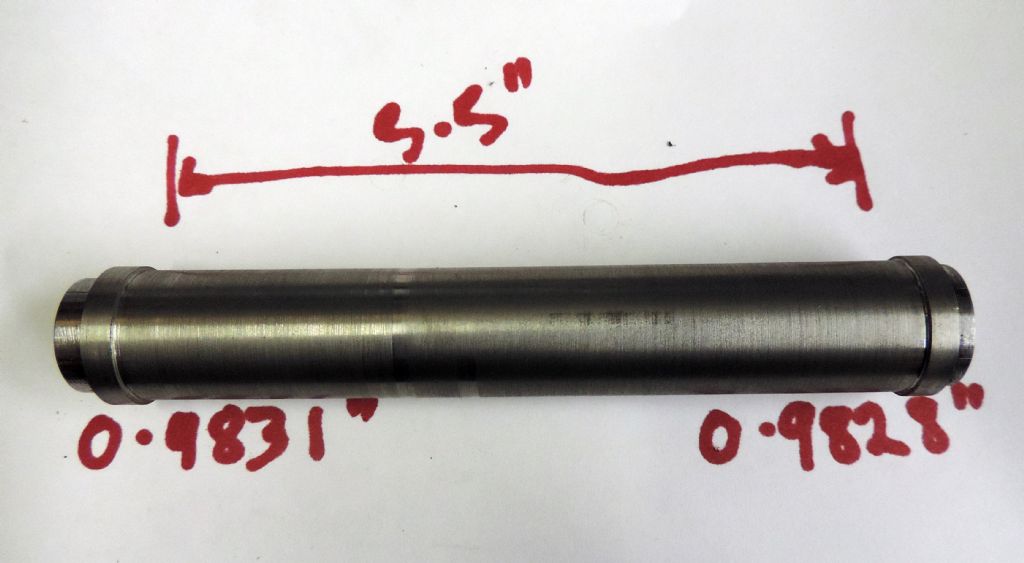I don't like the idea of twisting the bed to true a lathe up. If you correct say 0.001" at 3" it's going to move the end of the bed by bed lenght / 3" x what ever the error is. That then is taken out with tailstock adjustment. What I generally do is make up some screw jacks sensibly or with just nuts and bolts and mount the bed strain free by adjusting with my fingers then tightening down onto the jacks.
It sounds like you could make a decent ordinary between centre test bar providing you have a good sensitive DTI. Might be a better way of seeing what is going on. Just use the 4 jaw, with a length of say 1" silver steel with little sticking out of the chuck. Aim to get that running true as good as you can. Ideal is no deflectuon on a 1/10,000 reading DTI. Face it and lightly centre drill it slowly. That will come out central as they cut on on side if the tailstock is out. Then do the same to the other end. You can make them like a posh one. Turn down the OD a bit for say 3/8", chamfer and turn a shallow recess in the end and then centre drill. This just protects the important bits from bumps. Or of course buy one. Not useful that often but if it has a morse taper on it can also be used to check the headstock. It's best to check that the headstock bearings are fully home.
To use that check the top first by running a dti over the top at several places with the cross slide. This gives you and idea of height problems. Then run the diti along the side. If your feeling manic it's possible to work out what any height difference will do to the readings on the side. The height tolerance on the tailstock is often – 0 to plus something. Often 0.05 / 0.002" I assume this is better when that is corrected by offsetting the tailstock rather than it being low. Not sure.
Anyway using the bar you can align the tail stock as well as it can be. You could also do turning tests and offset as per Neils suggestion.
Also or even instead when it's pretty accurate and if the height variation is even suggesting that the tailstock is a touch high and the bed is flat …………….
What I have done when needed is to re ream the morse socket in the tailstock to remove the last few thou of error. Not at all sure how to do this on a light weight lathe but you have a decent one. Fit a morse reamer in the 3 jaw. I'm assuming that runs pretty true, it helps to rotate work just as the jaws close on it. You should feel some resistance. Then extend the tailstock quill by a couple of inches and slide the tailstock down the bed onto the reamer. You will only be removing a few thou. The whole thing will find it's own centre, the weight of the tailstcok is enough to do that. Just like a centre drill a morse reamer will cut on one side if needed so tends to sweep out the correct angle and then true the lot up.
The biggest risk with this is that it's already been done like this several times and when you put something in the socket next to no morse taper sticks out. Done correctly that will hardly change.
1" bar will be fine for turning tests if there is a centre in the end, If it's just chucked 1 1/2 or even 2" is needed really and even 1 1/2" is likely to flex a bit. 6" is usually used because most lathe work is reckoned to be shorter than that – except when there is a centre in the end.
 Forgot to mention – if you do make a between centre bar and rotate it against a dti the deflection should be very low or something has gone wrong, bent bar or centre not true. They may be a touch out in an angular fashion due to the way it has been made but that should make very little difference. If you buy one they are usually spec'd to +/- 0.0002 or 0.0005. It is possible to make one to similar limits.
Forgot to mention – if you do make a between centre bar and rotate it against a dti the deflection should be very low or something has gone wrong, bent bar or centre not true. They may be a touch out in an angular fashion due to the way it has been made but that should make very little difference. If you buy one they are usually spec'd to +/- 0.0002 or 0.0005. It is possible to make one to similar limits.
John
–
Edited By Ajohnw on 06/08/2016 23:06:01
Edited By Ajohnw on 06/08/2016 23:12:58
Edited By Ajohnw on 06/08/2016 23:13:43
All these edits – too quick as I want to go to bed.
Edited By Ajohnw on 06/08/2016 23:15:16
Ajohnw.





